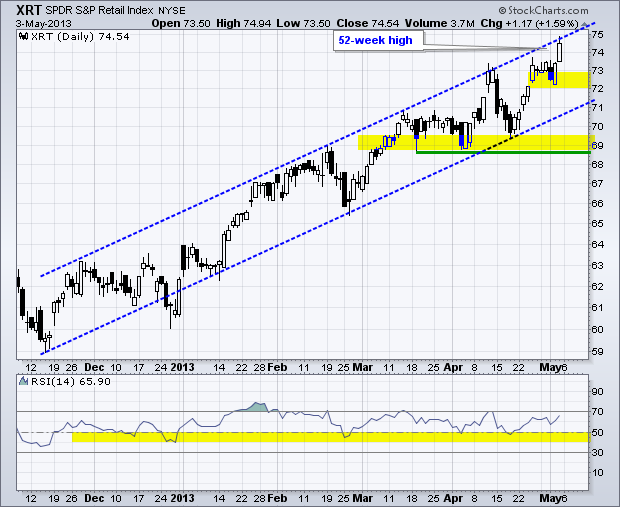It seems that market sentiment has done a 180 over the last few weeks. The defensive sectors went from leaders to laggards as the Consumer Discretionary SPDR (XLY) and Technology SPDR (XLK) led the market higher. The March employment report was a big disappointment, but the April report showed improvement and the February-March numbers were revised higher. This was enough to send Treasuries sharply lower and stocks sharply higher. IWM, QQQ and SPY all surged to new highs. XLY, XLF and XLK hit new highs as well. The Home Construction iShares (ITB) and Retail SPDR (XRT) also hit new highs. Even though stocks are once again short-term overbought, it is hard to argue with relative strength in homebuilders, retailers and the consumer discretionary sector. The chart below shows XRT hitting the top of a rising channel, which may provide some short-term resistance after a 7% surge the last 11 days.





**************************************************************************

**************************************************************************

**************************************************************************

**************************************************************************

**************************************************************************
Key Reports and Events (all times Eastern):
Tue - May 07 - 15:00 - Consumer Credit
Wed - May 08 - 07:00 - MBA Mortgage Index
Wed - May 08 - 10:30 - Crude Inventories
Thu - May 09 - 08:30 - Initial Claims
Thu - May 09 - 10:30 - Natural Gas Inventories
Fri – May 10 – 08:00 - TGIF
Charts of Interest: Tuesday and Thursday
This commentary and charts-of-interest are designed to stimulate thinking. This analysis is
not a recommendation to buy, sell, hold or sell short any security (stock ETF or otherwise).
We all need to think for ourselves when it comes to trading our own accounts. First, it is
the only way to really learn. Second, we are the only ones responsible for our decisions.
Think of these charts as food for further analysis. Before making a trade, it is important
to have a plan. Plan the trade and trade the plan. Among other things, this includes setting
a trigger level, a target area and a stop-loss level. It is also important to plan for three
possible price movements: advance, decline or sideways. Have a plan for all three scenarios
BEFORE making the trade. Consider possible holding times. And finally, look at overall market
conditions and sector/industry performance.

About the author:
Arthur Hill, CMT, is the Chief Technical Strategist at TrendInvestorPro.com. Focusing predominantly on US equities and ETFs, his systematic approach of identifying trend, finding signals within the trend, and setting key price levels has made him an esteemed market technician. Arthur has written articles for numerous financial publications including Barrons and Stocks & Commodities Magazine. In addition to his Chartered Market Technician (CMT) designation, he holds an MBA from the Cass Business School at City University in London.
Learn More





